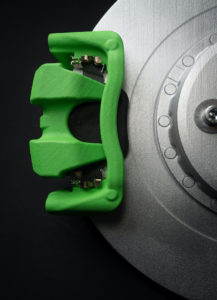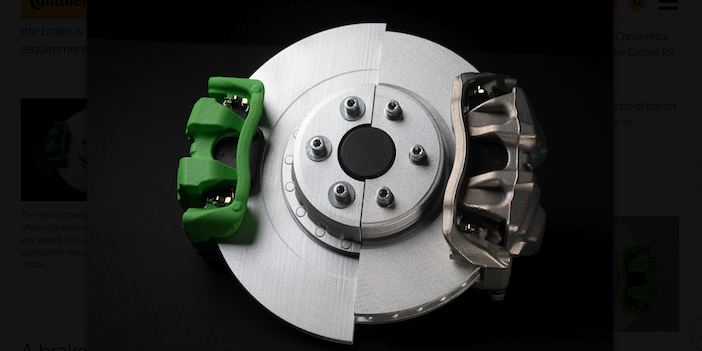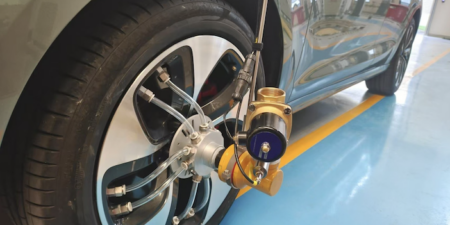A lightweight brake caliper has been developed to help increase the range of electric vehicles. The ‘Green Caliper’ is claimed by its creator, Continental, to be ‘significantly lighter’ than previous caliper designs and to have a lower residual brake torque. The lower mass – up to 5kg lighter per corner, according to Continental – and the reduced friction between brake pad and disc can help increase the range of an electric vehicle.
The brakes of an electric car are activated much less frequently than those of a conventional ICE-powered vehicle, as in more than 80% of all deceleration situations, the recuperation system slows the vehicle rather than the braking system. However, while the calipers of EVs may be activated less frequently, the added weight of the battery in an electric car means the brakes often need to perform more strongly than regular car brakes. On the other hand, the thermal load on EV brakes is lower because of that infrequent application. the brake is used much less frequently. These changed demands of calipers led Contineintal’s engineers to develop a brake caliper design optimised for EVs.
“Increasing efficiency is a primary goal in the optimisation of electric vehicles. The lower the loss of electrical energy, the greater the range of the vehicle,” explained Dominik Hiss, head of friction brakes and hydraulic brake systems at Continental. “Brakes can make a contribution that has not been exploited to date. With the new Green Caliper, we are providing a production-ready technology that unlocks additional potential for the range of an electric car.”
How it works
Hiss and his team analysed EV braking systems and found that in the comfort braking range of a vehicle – up to around 0.3 g of deceleration – the foundation brake is hardly needed. The so-called ‘blending area’, which is where the seamless transition between recuperation and foundation brake use occurs, controlled by the electronic brake system, only happens beyond this point. The foundation brake is only active on its own during emergency braking.
 These changing requirements led the Continental team to develop a more compact cast-iron fist caliper, which enables smaller and thinner brake pads to be used, as their infrequent use means they wear out slowly. Thus, the mass of the caliper is reduced, by up to 2kg per caliper.
These changing requirements led the Continental team to develop a more compact cast-iron fist caliper, which enables smaller and thinner brake pads to be used, as their infrequent use means they wear out slowly. Thus, the mass of the caliper is reduced, by up to 2kg per caliper.
At the same time, the lower bridge height of the smaller brake caliper enables a larger cast iron brake disc to be installed. Due to the reduced thermal load, the disc can be made significantly thinner, which offsets the weight by up to 3kg per disc. Since the brake engages further out on the larger disc and thus achieves high deceleration power with the same clamping force due to the longer lever arm, the braking performance is optimised.
Also, with a view to improving vehicle efficiency, the Green Caliper retracts the brake pads after each braking action, which reduces the residual brake torque between the pads and the disc to less than 0.2 newton meters, meaning almost loss-free operation. A further design innovation ensures that the air gap between the pad and disc is larger, and evenly distributed on both sides of the brake.
In combination with Continental’s MK C2 brake-by-wire brake system and an electronic pedal, a longer trajectory of the pads (which can reduce residual torque) can be demonstrated without any noticeable effect on the brake pedal.
Continental says the Green Caliper design is proven, with a lead time for application into vehicles of two to three years.





